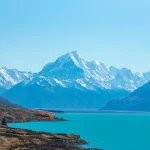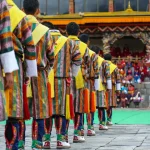
Discovering the Enchanting Beauty of Leh-Ladakh in Jammu and Kashmir

Introduction to Leh-Ladakh: A Land of Enchanting Beauty
Leh-Ladakh, located in the northernmost part of India, is a region known for its enchanting beauty and breathtaking landscapes. Nestled in the Himalayas, this remote destination has become increasingly popular among tourists in recent years. With its stunning mountain ranges, crystal-clear lakes, and ancient monasteries, Leh-Ladakh offers a unique and unforgettable experience for travelers.
One of the main reasons why Leh-Ladakh has become a popular tourist destination is its natural beauty. The region is home to some of the highest mountain peaks in the world, including K2 and Nanga Parbat. The picturesque landscapes, with their snow-capped mountains, lush green valleys, and pristine lakes, attract nature lovers and adventure enthusiasts from all over the world.
What sets Leh-Ladakh apart from other tourist destinations is its unique culture and traditions. The region is predominantly Buddhist, and you can find numerous monasteries and temples scattered throughout the area. The locals are warm and welcoming, and their way of life is deeply rooted in their ancient traditions. From colorful festivals to traditional dances and music, Leh-Ladakh offers a glimpse into a rich cultural heritage that is truly captivating.
The Best Time to Visit Leh-Ladakh: Planning Your Trip
When planning a trip to Leh-Ladakh, it is important to consider the weather conditions throughout the year. The region experiences extreme weather conditions, with freezing temperatures in winter and scorching heat in summer. The best time to visit Leh-Ladakh is during the summer months, from May to September, when the weather is pleasant and the roads are accessible.
The peak tourist season in Leh-Ladakh is during the months of June to August when the weather is at its best. During this time, you can expect clear skies, mild temperatures, and vibrant landscapes. However, it is also the busiest time of the year, with large crowds of tourists flocking to the region. If you prefer a quieter and more peaceful experience, you may want to consider visiting during the shoulder seasons of May and September.
Visiting Leh-Ladakh during the off-season has its advantages. The region is less crowded, and you can enjoy a more authentic experience. The prices for accommodation and transportation are also lower during this time. However, it is important to note that some roads and passes may be closed due to heavy snowfall, so it is essential to check the weather conditions and road conditions before planning your trip.
When planning your trip to Leh-Ladakh, it is important to take into consideration the high altitude of the region. Acclimatization is crucial to avoid altitude sickness. It is recommended to spend a few days in Leh, the capital city of Ladakh, before venturing into higher altitudes. It is also advisable to carry warm clothing, sunscreen, and plenty of water to stay hydrated.
Exploring the Culture and Traditions of Leh-Ladakh
Leh-Ladakh is a melting pot of different cultures and traditions. The region is predominantly Buddhist, with a strong influence from Tibetan culture. The locals follow a simple and peaceful way of life, deeply rooted in their ancient traditions.
One of the best ways to experience the local culture is by attending the various festivals and celebrations that take place throughout the year. The Hemis Festival, held in June or July, is one of the most popular festivals in Leh-Ladakh. It celebrates the birth anniversary of Guru Padmasambhava, the founder of Tibetan Buddhism. During the festival, you can witness colorful masked dances, traditional music performances, and vibrant processions.
In addition to festivals, there are several must-visit cultural sites in Leh-Ladakh. The Diskit Monastery, located in the Nubra Valley, is one of the oldest and largest monasteries in the region. It houses a 32-meter tall statue of Maitreya Buddha, which is a major attraction for tourists. The Alchi Monastery, known for its ancient wall paintings and sculptures, is another must-visit cultural site.
The Top Tourist Attractions in Leh-Ladakh: Must-Visit Places
Leh-Ladakh is home to several top tourist attractions that are worth visiting. From ancient monasteries and temples to natural wonders and historical sites, there is something for everyone in this enchanting region.
One of the main attractions in Leh-Ladakh is the Thiksey Monastery. Located on top of a hill, this monastery offers panoramic views of the surrounding landscapes. It houses a large statue of Maitreya Buddha and is known for its beautiful wall paintings and sculptures.
Another must-visit place in Leh-Ladakh is Pangong Lake. This stunning lake, located at an altitude of 4,350 meters, stretches across the border between India and China. Its crystal-clear blue waters and breathtaking surroundings make it a popular spot for photography enthusiasts.
For history buffs, the Leh Palace is a must-visit attraction. Built in the 17th century, this nine-story palace offers panoramic views of the city and the surrounding mountains. It houses a museum that showcases artifacts from the region’s rich history.
Adventure Activities in Leh-Ladakh: Trekking, Rafting, and More
Leh-Ladakh is a paradise for adventure enthusiasts. The region offers a wide range of adventure activities that allow you to explore its rugged landscapes and experience an adrenaline rush.
Trekking is one of the most popular adventure activities in Leh-Ladakh. There are several trekking trails that cater to different levels of difficulty and duration. The Markha Valley Trek, the Chadar Trek, and the Stok Kangri Trek are some of the most famous treks in the region.
River rafting and kayaking are also popular activities in Leh-Ladakh. The Zanskar River, with its rapids and gorges, offers an exhilarating experience for rafting enthusiasts. The Indus River is another popular spot for river rafting and kayaking.
Mountain biking and motorbiking are other adventure activities that allow you to explore the rugged terrains of Leh-Ladakh. The region offers several biking routes that take you through picturesque landscapes and remote villages.
Food and Cuisine of Leh-Ladakh: A Culinary Journey
The food and cuisine of Leh-Ladakh are a reflection of its unique culture and geography. The region offers a variety of dishes that are influenced by Tibetan, Kashmiri, and Indian cuisines.
One of the must-try dishes in Leh-Ladakh is momos. These steamed dumplings, filled with vegetables or meat, are a popular street food in the region. Another popular dish is thukpa, a hearty noodle soup that is perfect for the cold weather.
For meat lovers, try the traditional Ladakhi dish called skyu. It is a hearty stew made with wheat flour dough balls, vegetables, and meat. Another popular meat dish is rogan josh, a Kashmiri specialty made with tender pieces of lamb cooked in a rich gravy.
When it comes to beverages, butter tea is a must-try in Leh-Ladakh. It is a traditional Tibetan tea made with butter, salt, and tea leaves. It is a great way to warm up in the cold weather.
Accommodation Options in Leh-Ladakh: From Budget to Luxury
Leh-Ladakh offers a wide range of accommodation options to suit every budget and preference. From budget-friendly guesthouses to luxury resorts, you can find a place to stay that meets your needs.
For budget travelers, there are several guesthouses and homestays available in Leh-Ladakh. These accommodations offer basic amenities and a chance to experience the local way of life. They are a great option for those who want to immerse themselves in the culture and traditions of the region.
Mid-range hotels and resorts are also available in Leh-Ladakh. These accommodations offer comfortable rooms, modern amenities, and sometimes even spa facilities. They are a great option for those who want a bit more comfort and luxury during their stay.
For those looking for a luxurious experience, there are several high-end hotels and resorts in Leh-Ladakh. These accommodations offer spacious rooms, gourmet dining options, and world-class facilities. They are perfect for those who want to indulge in luxury and relaxation.
Getting Around in Leh-Ladakh: Transportation and Travel Tips
Getting around in Leh-Ladakh can be a bit challenging due to its remote location and rugged terrains. However, there are several transportation options available that can help you explore the region.
The most common mode of transportation in Leh-Ladakh is by road. You can hire a taxi or rent a car to explore the region at your own pace. It is important to note that the roads in Leh-Ladakh can be treacherous, especially during the monsoon season, so it is advisable to hire an experienced driver.
Another popular mode of transportation is by motorcycle or bike. Many tourists opt for this option as it allows them to enjoy the scenic landscapes and rugged terrains of Leh-Ladakh. There are several rental agencies in Leh that offer motorcycles and bikes for hire.
If you prefer public transportation, there are buses that connect Leh with other major cities in the region. However, the frequency of buses may be limited, so it is advisable to check the schedules in advance.
Shopping in Leh-Ladakh: Souvenirs and Local Handicrafts
Shopping in Leh-Ladakh is a unique experience, with a wide range of souvenirs and local handicrafts available. From traditional clothing and jewelry to handmade carpets and pottery, there is something for everyone.
One of the must-buy souvenirs in Leh-Ladakh is the Pashmina shawl. Made from the wool of the Changthangi goat, these shawls are known for their softness and warmth. They are available in a variety of colors and designs.
Another popular souvenir is the Tibetan prayer flag. These colorful flags, inscribed with prayers and mantras, are believed to bring good luck and prosperity. They make for a great decoration for your home or garden.
When it comes to local handicrafts, Leh-Ladakh is known for its intricate Thangka paintings. These traditional Buddhist paintings depict various deities and scenes from Buddhist mythology. They are a great way to bring a piece of Leh-Ladakh’s culture and traditions back home.
Leh-Ladakh Beyond Touristy Spots: Offbeat Places to Explore
While the popular tourist spots in Leh-Ladakh are definitely worth visiting, there are also several offbeat places that offer a different perspective of the region. These hidden gems and lesser-known attractions allow you to explore the untouched beauty of Leh-Ladakh.
One such offbeat place is Turtuk, a small village located near the Line of Control between India and Pakistan. This remote village offers stunning views of the Karakoram Range and allows you to experience the local Balti culture.
Another offbeat destination is Lamayuru, known as the Moonland of Ladakh due to its unique lunar-like landscapes. This ancient village is home to one of the oldest monasteries in Ladakh and offers breathtaking views of the surrounding mountains.
For those looking for a spiritual experience, the village of Phugtal is a must-visit. Located in a remote valley, this ancient monastery is carved into the side of a cliff and offers a peaceful and serene atmosphere.
Conclusion:
Leh-Ladakh is a land of enchanting beauty, with its stunning landscapes, rich culture, and adventurous activities. Whether you are a nature lover, an adventure enthusiast, or a cultural explorer, this region offers something for everyone. From exploring ancient monasteries and temples to trekking through rugged terrains and indulging in local cuisine, Leh-Ladakh promises an unforgettable experience. So pack your bags and get ready to embark on a journey to this magical land.
If you’re planning a trip to Leh-Ladakh in Jammu and Kashmir, you might also be interested in exploring the wonders of Sweden. From its stunning landscapes to its rich history and culture, Sweden offers a unique travel experience. Whether you’re exploring the vibrant city of Stockholm or venturing into the picturesque countryside, there’s something for everyone in this Scandinavian gem. Check out this article on Destination Mate for more information: Exploring the Wonders of Sweden.
Recent Posts


Discovering the Wonders of New Zealand: A Journey Through the Land of Kiwis and Stunning Scenery
